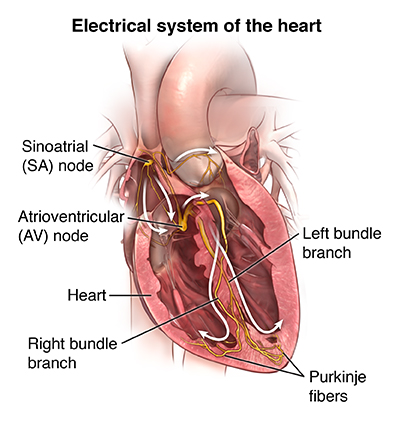Anomalous Coronary Artery Intervention
What is anomalous coronary artery intervention?
Anomalous coronary artery intervention is a procedure to fix a problem with the coronary artery. An anomalous coronary artery may have an irregularity with its starting point or its course, shape, or branching. This problem may cause the artery to be blocked or narrowed. During the procedure, the blocked part of the artery is opened up. Another name for this condition is coronary artery anomaly (CAA).
The heart pumps blood to the body and lungs. But it also needs its own supply of blood to stay alive. The coronary arteries supply blood to the heart muscle. These arteries start out in the aortic sinuses. The aortic sinuses are in the aorta. The aorta is the large blood vessel that sends blood from the heart out to the whole body.
There are two coronary arteries that normally start from these sinuses. The right coronary artery starts out from the right aortic sinus. The left coronary artery starts out from the left aortic sinus. These two arteries branch off into other coronary arteries that provide the blood supply to different parts of the heart.
In some people, the branching of the coronary arteries is abnormal. This occurs before birth. Experts don't know what causes it. It may cause no problems. But in some cases, major complications or even sudden death may occur.
Fatty deposits may form inside the arteries. This is called atherosclerosis. The deposits can block blood flow through the arteries. The arteries may also be squeezed (compressed) due to the abnormal paths they take.
To treat this condition, your healthcare provider can use angioplasty and a small mesh tube (stent) to fix the artery. The procedure is done with a thin, flexible tube (catheter) that has a tiny balloon at its tip. The catheter is put into a blood vessel in the groin or wrist. It’s then gently advanced to the coronary artery. The balloon is inflated. This pushes aside the fatty deposits and makes space in the artery. Or it opens up a compressed area. A stent is then put in the area. It’s left in place to keep the area open. The catheter is then removed.
Why might I need an anomalous coronary artery intervention?
Treatment is often advised for people with this condition who have symptoms. An anomalous coronary artery may not cause any symptoms. Or it may cause symptoms such as chest pain or fainting with exercise, or abnormal heart rhythms. This may mean that the heart muscle is not getting enough blood.
Getting treatment for a blocked anomalous coronary artery can prevent serious problems. These include lack of blood to the heart muscle (ischemia), irregular heart rhythms, and sudden cardiac death.
Some people with an anomalous coronary artery can be treated with medicines and lifestyle changes. In other cases, a person may need the intervention procedure. Or your healthcare provider may advise a different type of surgery. Talk with your provider about the risks and benefits of each procedure for you.
What are the risks of anomalous coronary artery intervention?
All procedures have risks. The risks of this procedure include:
-
Excessive bleeding
-
Blood vessel damage from the catheters
-
Infection
-
Blood clot that can lead to stroke or blockage of the stent
-
Abnormal heart rhythm, which can cause death in rare cases
-
Allergic reaction to the dye
-
Heart attack
-
Need for coronary artery bypass grafting, if the artery doesn’t open with the procedure
-
Death
Your risks may vary based on your overall health, the severity of your condition, and other factors. Ask your healthcare provider about which risks apply most to you.
How do I get ready for an anomalous coronary artery intervention?
Talk with your healthcare provider about how to get ready for your procedure.
-
Tell your healthcare provider about all the medicines you take. This includes prescription medicines and over-the-counter medicines such as aspirin. It also includes vitamins, herbs, supplements, or illegal drugs. You may need to stop taking some medicines ahead of time, such as blood thinners.
-
If you smoke, you’ll need to stop before your procedure. Talk with your healthcare provider if you need help to stop smoking.
-
Follow any directions you are given for not eating or drinking before your procedure.
-
Tell your healthcare provider about any recent changes in your health, such as a fever.
You may need some tests before the procedure, such as:
-
Chest X-ray. This shows the structures in and around the chest.
-
Electrocardiogram. This checks the heart rhythm.
-
Blood tests. These are done to check your general health.
-
Echocardiogram. This is done to see the heart and the blood flow through the heart.
-
Multidetector CT scan (MDCT) or cardiac MRI. These may be done if more information about the blood vessels is needed.
What happens during an anomalous coronary artery intervention?
Talk with your healthcare provider about what to expect during your procedure. The procedure often takes place in a cardiac catheterization lab. A cardiologist and a team of specialized nurses and technicians work together. A typical procedure may go like this:
-
An IV (intravenous) line will be put in your arm or hand before the procedure starts. You’ll be given sedation through the IV line. This will make you relaxed and sleepy during the procedure.
-
Hair in the area of your procedure may be removed. The area may be numbed with a local anesthesia.
-
The healthcare provider will make a small cut (incision) in a blood vessel in your groin or wrist. They will then put a long, thin wire into this cut. The wire acts as a guide during the procedure.
-
The healthcare provider will then insert a thin, flexible tube (catheter) over the wire. It has a tiny, deflated balloon on the end. The catheter will be threaded through the blood vessel all the way into the coronary artery. Continuous X-ray images may be used to show exactly where the catheter is.
-
The balloon will be inflated inside the narrow part of the artery. This will stretch the area open.
-
A mesh tube (stent) may be left in place in the area. This will help keep the area open.
-
The balloon will be deflated, and the catheter will be removed.
-
The incision site in the groin or wrist will be closed and bandaged.
What happens after an anomalous coronary artery intervention?
After the procedure, you will spend several hours in a recovery room. You may be sleepy and confused when you wake up. Your healthcare team will watch your vital signs, such as your heart rate and breathing. You’ll be given pain medicine if you need it.
You may need to lie flat without bending your legs for several hours after the procedure. This is to help prevent bleeding from the incision site. You will need to stay in the hospital overnight. Your healthcare provider will tell you more about what to expect.
After you go home, you may need to take medicines to help prevent blood clots. You may need to take them for a short time, or take them for a longer time. You may also need to take antibiotics. Your healthcare provider will let you know about any other changes in your medicines. You can take pain medicine at home if you need it. Ask your healthcare provider which to take.
You can resume your normal activities when you get home. But do not do strenuous activities or heavy lifting for several days. Your healthcare provider may give you more instructions.
Make sure to keep all of your follow-up appointments. This will help your healthcare provider keep track of your progress. Your provider may order follow-up tests. These may include an electrocardiogram or an echocardiogram.
Call your healthcare provider right away if you have any of the following:
-
Swelling or pain that gets worse
-
Fluid or blood leaking from the incision site
-
Fever
-
Chest pain
-
Trouble breathing
Follow all of your healthcare provider’s instructions. This includes any advice about medicines, exercise, and wound care.
Next steps
Before you agree to the test or the procedure, make sure you know:
-
The name of the test or procedure
-
The reason you are having the test or procedure
-
What results to expect and what they mean
-
The risks and benefits of the test or procedure
-
What the possible side effects or complications are
-
When and where you are to have the test or procedure
-
Who will do the test or procedure and what that person’s qualifications are
-
What would happen if you did not have the test or procedure
-
Any alternative tests or procedures to think about
-
When and how you will get the results
-
Who to call after the test or procedure if you have questions or problems
-
How much you will have to pay for the test or procedure





